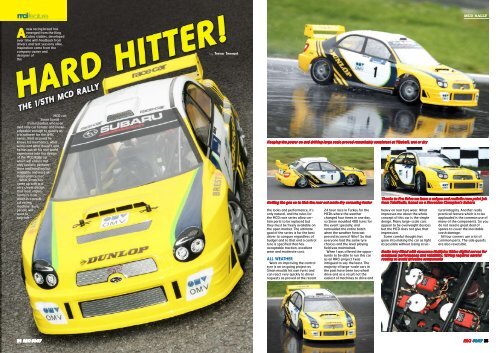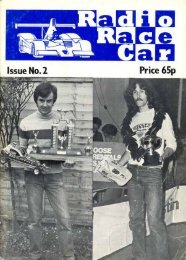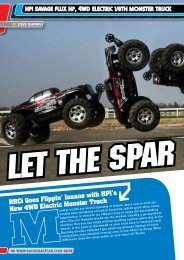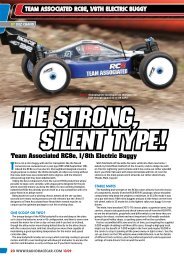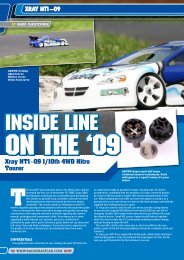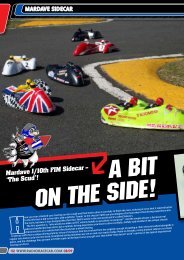ALL WEATHER - Radio Race Car International Magazine
ALL WEATHER - Radio Race Car International Magazine
ALL WEATHER - Radio Race Car International Magazine
You also want an ePaper? Increase the reach of your titles
YUMPU automatically turns print PDFs into web optimized ePapers that Google loves.
MCD R<strong>ALL</strong>Y<br />
Anew racing breed has<br />
emerged from the King<br />
Cobra stables, developed<br />
over time with feedback from<br />
drivers and test sessions alike.<br />
Inspiration came from the<br />
company owner and<br />
designer of<br />
the<br />
by Trevor Tennant<br />
MCD car,<br />
Sinan Sunali<br />
from Istanbul, who is an<br />
avid rally car fanatic and knowledgeable<br />
enough to qualify as<br />
a scrutineer for the WRC<br />
series. Rest assured he<br />
knows his mechanics, what<br />
works and what doesn’t and<br />
he has put all his real world<br />
experience into the design<br />
of the MCD Rally car<br />
which will ensure not<br />
only realistic performance<br />
and handling but<br />
reliability and ease of<br />
maintenance too!<br />
What Sinan has<br />
come up with is a<br />
very clever design<br />
that most importantly<br />
is a car<br />
which is a practical<br />
racing<br />
machine. Sure,<br />
people will<br />
want to<br />
upgrade<br />
Keeping the power on and drifting large scale proved remarkably consistent at Tibshelf, wet or dry<br />
Getting the gas on to kick the rear out made dry cornering faster<br />
the looks and performance, it’s<br />
only natural, and the rules for<br />
the MCD race series allow certain<br />
parts to be replaced but<br />
they must be freely available on<br />
the open market. The ultimate<br />
goal of the series is for the best<br />
driver to conquer regardless of<br />
budget and to that end a control<br />
tyre is specified that has<br />
acceptable traction, excellent<br />
wear and moderate cost.<br />
<strong>ALL</strong> <strong>WEATHER</strong><br />
Work on improving the control<br />
tyre is an on going project as<br />
Sinan moulds his own tyres and<br />
can react very quickly to driver<br />
requests as proved at the recent<br />
24 hour race in Turkey for the<br />
MCDs where the weather<br />
changed four times in one day,<br />
so Sinan moulded 400 tyres for<br />
the event specially, and<br />
remoulded the entire batch<br />
when the weather forecast<br />
proved incorrect! Why? So that<br />
everyone had the same tyre<br />
choices and the level playing<br />
field was maintained.<br />
When I was offered the opportunity<br />
to be able to run this car<br />
as an RRCi project I was<br />
intrigued to say the least. The<br />
majority of large-scale cars in<br />
the past have been two wheel<br />
drive and as a result not the<br />
easiest of machines to drive and<br />
Thanks to Pro Drive we have a unique and realistic race paint job<br />
from TelsShells, based on a Slovenian Champion’s Subaru<br />
heavy on rear tyre wear. What<br />
impresses me about the whole<br />
concept of this car is the simple<br />
design. Many large-scale cars<br />
appear to be overweight devices<br />
but the MCD does not give that<br />
impression.<br />
Some careful thought has<br />
gone into making the car as light<br />
as possible without losing structural<br />
integrity. Another really<br />
practical feature which is to be<br />
applauded is the common use of<br />
many of the components. So you<br />
do not need a great deal of<br />
spares to cover the inevitable<br />
crash damage.<br />
All four corners use a lot of<br />
common parts. The side guards<br />
are also reversible.<br />
<strong>Radio</strong> tray fitted with awesome Multiplex Rhino digital servos for<br />
maximum performance and reliability. Wiring requires careful<br />
routing to avoid driveline components<br />
24 RRCi 03/07<br />
RRCi 03/07 25
MCD R<strong>ALL</strong>Y<br />
Equi-spaced Intermediate gear train, gives a choice of 12 ratios<br />
A rubber gasket keeps the lid sealed to the radio box<br />
MCD wheels feature steel insert hex drive<br />
King Cobra modified Zenoah G260RC 26 cc engine suits MCD cars<br />
Toe out at the front and toe in at the rear gives stability with keen<br />
steering responses<br />
Well we couldn’t do it blue could we. The MCD dwarfs a 1/18th<br />
version<br />
GET A GRIP<br />
The car is supplied ready<br />
assembled with only the engine<br />
and radio fitment required. The<br />
tyres are fitted but you will have<br />
to adhere the tyres to the rims<br />
with a slow drying Cyno adhesive.<br />
Owing to the weight of the<br />
car the tyre/rim joints take a lot<br />
of stick so the preparation and<br />
gluing method is crucial to long<br />
tyre life and good performance<br />
by getting it properly seated and<br />
perfectly concentric.<br />
I used a sanding drum in a<br />
Dremel to scuff up the edges of<br />
the tyre at the glue joints. A<br />
large hose clip is a great help to<br />
squeeze the tyre lip firmly onto<br />
the hub. To do a decent job here<br />
is quite time consuming but well<br />
worth all the hassle. Use a good<br />
quality thick CA like the Pro-Line<br />
series or the new Slow Cure CA<br />
from Weston UK to get a really<br />
professional finish.<br />
STAY IN CONTROL<br />
As the MCD is quite a good<br />
heavier than even a 1/8th scale<br />
Monster Truck some seriously<br />
powerful servos are in order.<br />
Thanks to Multiplex we have<br />
been able to fit 3 of their superb<br />
Rhino DIGI 4 servos. The specification<br />
is very high and the cost<br />
per unit represents excellent<br />
value for money.<br />
The servos come with strong<br />
nylon operating horns which we<br />
have used on our model, but<br />
optional alloy servo horns are<br />
also available for extreme<br />
strength with a little bling factor.<br />
It was decided to use the rubber<br />
THE RHINO DIGI 4 NO<br />
65128 SPECIFICATION<br />
Metal Geared<br />
3 ball races on output shafts<br />
Size 59 mm x 29 mm x 55 mm<br />
Weight 175 grams (6.1 oz)<br />
Torque at 6 Volts = 250 Ncm<br />
Holding power at 6 Volts =<br />
225 Ncm<br />
Transit speed at 6 Volts =<br />
0.10 (40°)<br />
The front and rear differential gear sets utilise a helical tooth<br />
form for better wear properties<br />
grommets to isolate the servo<br />
cases from the radio plate to<br />
improve vibration resistance and<br />
help a little with shock<br />
absorbency/isolation. Thankfully<br />
Multiplex servos all come with<br />
the Universal fitment plug these<br />
days so they fitted to our<br />
receiver straight out of the box.<br />
Fitting the servos was quite<br />
straight forward making very<br />
certain that the two steering<br />
servo horns were alighted precisely.<br />
This is a vital aspect<br />
because you do not want the<br />
two servos fighting one another.<br />
I was advised to use the larger<br />
Rhino servo on the<br />
throttle/brake system but you<br />
can via the supplied adaptor<br />
pieces install a medium size<br />
servo to save some weight.<br />
Routing the servo leads requires<br />
some thought to avoid the central<br />
driveshaft and gears to<br />
avoid any premature failures so<br />
take your time and keep it tidy.<br />
The radio box will hold up to<br />
five sub-C size cells and the<br />
receiver. On our car I have used<br />
GP 3300 cells and the configuration<br />
is such that unless you<br />
purchase the MCD specified<br />
receiver pack you will have to<br />
custom build your own.<br />
The switch unit includes a<br />
flashing LED that operates when<br />
the radio is turned on. With the<br />
BRCA allowing Spektrum 2.4<br />
GHz to be used by finally being<br />
voted in at the latest AGM, the<br />
choice of receiver was obvious.<br />
Similarly an AMB personal<br />
transponder is essential racing<br />
kit and once you’ve raced with<br />
2.4 GHz and a PT there really is<br />
no going back to the ‘Dark Old<br />
Days’.<br />
5 mm damper shafts compliment the heavy-duty shocks<br />
IT’S NOT <strong>ALL</strong> ABOUT<br />
POWER<br />
The one fundamental issue<br />
with large scale is the typical<br />
two-stroke engine which in the<br />
beginning were designed to be<br />
used in the harsh world of industrial<br />
and domestic gardening.<br />
User-friendly chassis characteristics<br />
are considered more<br />
important than trying to construct<br />
a lightweight chassis with<br />
the ultimate power output, so<br />
starting the machine easily and<br />
reliably is the number one priority.<br />
As a result the engines are<br />
built to take some serious abuse<br />
without falling apart which is<br />
great for racing but means they<br />
are usually over engineered.<br />
The featured class allows any<br />
suitable engine to be used. They<br />
range in capacity from 23 to 29<br />
cc and they can be tuned if<br />
desired, bearing in mind however<br />
that the tyre rules effectively<br />
restrict the traction available, so<br />
it may not be such a good idea<br />
to have the engine tuned so<br />
much that the car spins all four<br />
wheels excessively. Good driving<br />
technique is the route to track<br />
success. The Americans are<br />
always going on with a great<br />
degree of conviction about driving<br />
slow to go fast; the great Joel<br />
Johnson being an excellent<br />
example of the breed.<br />
This is the method where you<br />
do not mash the throttle and<br />
saw at the steering. His ideas are<br />
you should restrict the steering<br />
throw and place the car in the<br />
correct place on the track whenever<br />
possible and I know it<br />
works.<br />
Watch the really great drivers<br />
and their main weapon is<br />
smoothness allied to great race<br />
awareness.<br />
Returning to the engine issue<br />
you are allowed to use any<br />
Zenoah or similar in any capacity<br />
between 23 and 29 cc. I<br />
understand that surprisingly the<br />
difference in performance is not<br />
that pronounced between any of<br />
them. Our MCD is using the<br />
Zenoah 26 cc G260RC unit in<br />
standard tune.<br />
Because of the freely available<br />
replacement parts buying a used<br />
Solid dependable front suspension arrangement is fully<br />
adjustable<br />
engine can be an economical<br />
proposition. You must make certain<br />
it includes the standard<br />
centrifugal clutch hub and shoes<br />
along with the relevant mounting<br />
casting.<br />
One thing that has to be done<br />
to the engine is that the bottom<br />
of the crankcase has to be<br />
relieved to allow the central driveshaft<br />
to pass through the<br />
engine. Any engine supplied for<br />
MCD application will come<br />
already machined, but King<br />
Cobra will machine your existing<br />
engines for a sum of £25.00<br />
which would be a wise investment<br />
as you don’t want to wreck<br />
your engine using an angle<br />
grinder do you? (It has happened<br />
I gather at a meeting where the<br />
resident club ‘expert’ trashed<br />
someone’s engine – oops!)<br />
THE BODY BEAUTIFUL<br />
The TelsShels paint job is just<br />
excellent, replicating a Slovenian<br />
Rally Champion’s Subaru Impreza<br />
WRC which was tracked down<br />
with help from Pro Drive who<br />
were only too glad to help us find<br />
a unique and striking yet realistic<br />
Subaru colour scheme. Well we<br />
just couldn’t do another Blue one<br />
could we, far too easy!<br />
The front bumper foam block<br />
comes ready to trim to fit snugly<br />
inside any of the bodyshells<br />
available for this scale, so take<br />
your time and go steady, a close<br />
fit will keep your bodyshell looking<br />
great for much longer, but<br />
leave it too big and you’ll stress<br />
the bodyshell against the body<br />
mounting posts, cut it too small<br />
and your front end will flap in the<br />
wind and flex during crashes,<br />
increasing the chances of a split<br />
developing in the thick Lexan.<br />
The engine requires premix<br />
lubrication, but don’t go slapping<br />
any old oil in the petrol that you<br />
find on the shelf at the petrol station.<br />
King Cobra has tried numerous<br />
oils over a period of several<br />
years and has been instrumental<br />
in developing a specific racing oil<br />
for large scale models with the<br />
26 RRCi 03/07<br />
RRCi 03/07 27
MCD R<strong>ALL</strong>Y<br />
Buried inside the gear train are the cam operated triple brake<br />
discs<br />
Primary drive from the gearbox output is via a bevel gear on the<br />
propshaft centre mount<br />
Racing Venom was developed<br />
by Rock Oil for King Cobra to<br />
suit large scale R/C applications<br />
Rock Oil company, and are now<br />
the sole source of the unique oils<br />
designed for these small fan<br />
assisted, air cooled engines.<br />
‘Racing Venom’ is the result of<br />
many racing seasons and driver<br />
feedback, and comes highly recommended.<br />
DON’T GET YOUR LINES<br />
TWISTED<br />
The fuel tank has a feed and<br />
return line to the carburettor, so<br />
when fitting the engine for the<br />
first time or if you ever service the<br />
car and remove the tubing be<br />
sure and get them back in the<br />
right locations or the engine will<br />
not start. The clear fuel line is the<br />
return, while the black line is the<br />
feed. The engine has a fuel-priming<br />
bulb to draw fuel up to get you<br />
going but once running the carb is<br />
self feeding.<br />
The main propeller shaft passes right through the petrol tank<br />
Rear suspension is well braced!<br />
The transmission design of this<br />
car is quite interesting, and the<br />
one thing that was immediately<br />
noticeable was that the whole<br />
drive train freed up significantly<br />
after a few minutes running.<br />
The engine came with the<br />
standard two shoe centrifugal<br />
clutch. It engages into a plain<br />
clutch bell that is shaft mounted<br />
via a pair of ball races on the<br />
outrigger gear set mounting.<br />
This transfers power through a<br />
gear driven hub that is held to<br />
the shaft by enormous grub<br />
screws against machined flats<br />
for a secure mounting.<br />
A nylon pinion has straight cut<br />
teeth and is fitted on the hub,<br />
retained by a nyloc nut. The pinion<br />
meshes with another pair of<br />
straight cut nylon gears that<br />
mesh with the gear mounted on<br />
the output shaft. The design is<br />
such that the gear pairs use<br />
identical shaft spacing to allow<br />
you to swap the gears around in<br />
various combinations and obtain<br />
a range of final drive ratios, to<br />
suit the track conditions. Pure<br />
genius!<br />
The output shaft has the brake<br />
discs mounted on it and it terminates<br />
in a spiral cut bevel gear.<br />
That gear meshes with a compatible<br />
gear that is mounted on<br />
a fully ball raced support housing.<br />
A pair of heavy section Dog<br />
Bone propshafts transfer the<br />
drive to the differentials front<br />
and rear while output shafts<br />
drive very sturdy CVA joints at<br />
the front and Dog Bone shafts at<br />
the rear.<br />
The differential assemblies<br />
once again use helical gears,<br />
where the action is shared over<br />
more than one gear tooth for<br />
better reliability and efficiency; a<br />
system used with great success<br />
for many years on full size motor<br />
vehicles. The servicing of the<br />
differential cases requires great<br />
care in reassembly. It is easy to<br />
get the main drive gear on<br />
crooked but I found the solution<br />
was to turn the output shaft and<br />
gently tap the outside face of<br />
the gear as the two clamping<br />
screws were tightened.<br />
Differential resistance can be<br />
adjusted by using a variety of<br />
lubrication media, altering the<br />
weight of the grease in the diff<br />
will change the way the car turns<br />
and the overall balance of grip<br />
Front suspension and twin post, double servo saver installation<br />
front to rear and once set up<br />
correctly the ability to throw this<br />
large car around like a 1/10th<br />
scale car was astonishing.<br />
THE PLAN<br />
In the first place the plan was to<br />
race the car at a winter series as a<br />
precursor to the TOPSA National<br />
series in 2007.<br />
Initial runs were done with the<br />
bodyshell removed to allow the<br />
engine extra cooling air while we<br />
checked the chassis build integrity,<br />
but are glad to reveal that<br />
everything is assembled perfectly<br />
and nothing shook loose in our<br />
initial trials.<br />
It is recommended that you run<br />
the highest octane rating fuel that<br />
you can get at a normal service<br />
station in these cars. I used Total<br />
97 but would prefer the Shell V<br />
Power if it was available closer to<br />
home.<br />
We took the MCD to the famous<br />
Tibshelf track to give the car a<br />
good workout on a high-speed<br />
yet very demanding circuit with<br />
plenty of corner variation and<br />
camber changes. On arrival we<br />
were lucky to find a bone-dry<br />
track so after a few easy laps to<br />
get acquainted to the track layout<br />
and bed the tyres into the surface<br />
we finally gave it full throttle and<br />
finally got to stretch its legs.<br />
One thing we changed was the<br />
gear ratio; from the base setting<br />
to the highest ratio possible to<br />
suit the wide-open sweepers of<br />
the Tibshelf circuit. This greatly<br />
improved the speed but made the<br />
engine run a little hotter so a<br />
small adjustment of the fuel mixture<br />
screw was required. A word<br />
here to those of you only used to<br />
running nitro engines, you will<br />
have to be far more precise with<br />
mixture adjustments when running<br />
a petrol running engine. After<br />
around 20 minutes running intermitted<br />
by several changes to the<br />
suspension setting the driver was<br />
able to get the car from 22 second<br />
laps down to a best of 18.6<br />
seconds which is right on the pace<br />
of the regular drivers so we were<br />
more than pleased with both the<br />
MCDs out of the box geometry<br />
and Stuarts braver on the sticks.<br />
Then down came the rain hard<br />
and we were pleased to find the<br />
control tyres gave a surprising<br />
amount of traction and when provoked<br />
the car could be thrown<br />
about with a reassuring degree of<br />
control.<br />
After approximately an hours<br />
running, proceedings were<br />
brought to a halt caused by the<br />
receiver battery going flat, which<br />
showed itself first as a reduction<br />
of braking effort.<br />
RACE DAY<br />
After such an encouraging start<br />
a visit to Halifax for a winter club<br />
racing series meeting was undertaken<br />
and through the course of<br />
the day several changes were<br />
made to the set up:<br />
FRONT SHOCKS<br />
Hard grade springs, FG 1000<br />
grade silicone oil, variable piston<br />
was adjusted to 2 holes open.<br />
REAR SHOCKS<br />
FG 500 grade oil, variable piston<br />
was adjusted to 2 holes open.<br />
The front steering arms were<br />
relocated above the steering drop<br />
arms to change the bump steer<br />
characteristics, and all the drive<br />
joints were liberally dosed in chain<br />
lube spray grease. The access<br />
holes in the Lexan body were<br />
increased to allow more air to flow<br />
through the body, and I fitted a<br />
ventilator pipe to the petrol tank<br />
to let it breath more easily.<br />
Arriving at the circuit quite early<br />
saw the racing surface still wet<br />
from all the rain that fell the day<br />
before. With little wind the track<br />
remained damp and greasy for<br />
the first 2 rounds of heats.<br />
Our MCD was joined by 2006<br />
TOPSA Champion Trevor Kersey<br />
who was using alternatively his 2<br />
wheel drive car and an MCD.<br />
Round one saw the two wheel<br />
drive cars really struggle at the<br />
end of 10 minutes Trevor was first<br />
with his two wheel driver and<br />
Stuart a good second commenting<br />
that traction even with 4WD<br />
was very difficult.<br />
Round 2 and the wind had come<br />
up and the track was beginning to<br />
dry out but still very greasy. This<br />
time Trevor used his MCD with<br />
some wet weather tyres and beat<br />
Stuart into second place again.<br />
Round 3 saw the track almost dry<br />
but a bottom suspension screw<br />
worked itself out wreaking any<br />
chance of improvement.<br />
Many of the 2WD entries<br />
improved this time and as a result<br />
Stuart started 4th on the grid for<br />
the final. The weather meanwhile<br />
had taken a turn for the worst<br />
with the rain coming down quite<br />
hard. At the hooter Stuart rapidly<br />
got up to second but as the rain<br />
came down harder the MCD tyres<br />
were not in the same league as<br />
the cars using discrete rain tyres.<br />
After much off roading the driver<br />
finished in 6th spot finding things<br />
a real struggle in the conditions.<br />
FEEDBACK<br />
Apart from the issue with the<br />
screw dropping out the car had<br />
been very reliable after quite a<br />
few contacts with others cars. We<br />
found that what the car needs to<br />
be truly competitive is a tuned<br />
pipe for the engine. The standard<br />
silencer gives away far too much<br />
power and the driver did very well<br />
with so little power. I understand<br />
that lightening the clutch shoes<br />
will improve the pick up from corners.<br />
The optional multi weather<br />
air filter set is a very good idea as<br />
is the rear suspension control rod<br />
sets.<br />
After the meeting the car was<br />
so dirty as to be a real job to get<br />
clean. I totally stripped the car<br />
down and jobs such as stripping<br />
out the gearboxes and replacing<br />
the kit grease with some CVA<br />
grease in the rear and some FG<br />
thick differential silicone grease<br />
in the front. I have now added<br />
some alloy nipples that allow you<br />
to spray chain lube into the gearbox<br />
cases. The brake discs were<br />
flattened along with the brake<br />
calliper plates with fine emery<br />
paper.<br />
CLASS: 1/5th 4WD Rally <strong>Car</strong><br />
TYPE: Pre-assembled chassis kit with<br />
trimmed clear shell<br />
MANUFACTURER: MCD<br />
PRICE: £875 RRP<br />
REQUIRED AND RECOMMENDED<br />
ENGINE: Zenoah G260RC<br />
RADIO: JR R1 with Spektrum 2.4 GHz<br />
SERVOS: Rhino Multiplex DIGI 4<br />
Digital<br />
FUEL: Unleaded 95 RON<br />
PRE MIX OIL: Rock Oil ‘Racing<br />
Venom’<br />
RECEIVER BATTERY: GP 3300 mAh<br />
5-cell, 6 V<br />
DISLIKES<br />
Side exit exhaust means cutting more<br />
windows out<br />
LIKES<br />
Drivability, in all weathers<br />
Spares back up<br />
Standard race formula with minimal<br />
mods<br />
Ratio options via interchangeable gears<br />
Sturdy and yet compact design<br />
Fully adjustable suspension<br />
CONTACT<br />
For more info contact the UK MCD<br />
importer, King Cobra Distribution Ltd<br />
on 01706 260502 or visit<br />
www.kingcobra.co.uk<br />
I understand that some new<br />
‘Thermal’ tyres will be available by<br />
the time you read this piece which<br />
have a wider temperature range,<br />
yet wear rate is lower than the<br />
earlier types. We can’t wait to try<br />
them!<br />
The intention is to race in the<br />
TOPSA series and update the car<br />
as and when required, so keep<br />
your eye on RRCi for all the news<br />
through the season as the MCD<br />
battles the best large-scale drivers<br />
around the country. If our initial<br />
impressions of the MCD are<br />
anything to go by, we should be in<br />
for a very productive and enjoyable<br />
season.<br />
Thanks to Bob Stiles at King<br />
Cobra Racing for the review car<br />
and all the help so far, and to<br />
Multiplex for the excellent Rhino<br />
servos.<br />
RRCi<br />
28 RRCi 03/07<br />
RRCi 03/07 29


